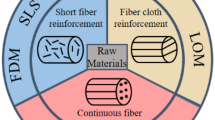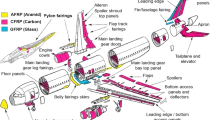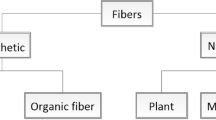Abstract
This article describes a novel method for detecting flaws in curing FRP composite materials while they are being manufactured. Such a method can improve the efficiency of the manufacturing process by minimizing, or potentially eliminating, the need for post-manufacturing inspection. The method utilizes a Kalman filter, a heat conduction model, and surface temperature measurements from infrared thermography to identify likely locations of flaw and/or curing anomalies. Specifically, a methodology that compares a metric of the time-history of Kalman filter corrections at different spatial locations to identify anomalous curing behavior was developed. Several numerical studies were performed using a previously-validated model to determine the proficiency of the technique. Results of the verification studies indicated that the proposed method was effective at identifying resin-rich regions without any modification to the detection criteria, while identifying resin-deficient regions required a more lenient detection criterion. In the case of multiple flaws, the proposed method was always able to identify the flaw closer to the surface, regardless of flaw significance, while the deeper flaw was only identified when the flaw was more significant than the near-surface flaw. The proposed method demonstrates promise for passive IR thermography-based flaw detection performed during the manufacturing of FRP composites and can serve to both improve the efficiency of the manufacturing process and the quality of FRP composite parts. Further experimental studies are required for validation of the technique before it can be applied for industrial application.








Similar content being viewed by others
Data Availability
The data produced for this article is available by request.
Code Availability
The MATLAB and Python codes utilized for the analyses presented in this article are available by request.
References
Hollaway, L.C.: A review of the present and future utilisation of FRP composites in the civil infrastructure with reference to their important in-service properties. Constr. Build. Mater. 24, 2419–2445 (2010). https://doi.org/10.1016/J.CONBUILDMAT.2010.04.062
Lubin, G.: Handbook of Composites. Springer Science & Business Media (2013)
Mangalgiri, P.D.: Composite materials for aerospace applications. Bull. Mater. Sci. 22, 657–664 (1999). https://doi.org/10.1007/BF02749982
Friedrich, K., Almajid, A.A.: Manufacturing aspects of advanced polymer composites for automotive applications. Appl. Compos. Mater. 20, 107–128 (2013). https://doi.org/10.1007/s10443-012-9258-7
Vaidya, U.: Advanced composite materials and manufacturing in vehicles, wind, and compressed gas storage. Text. World. (2017)
DOE, Office, A.M.: Fiber reinforced polymer composite manufacturing rfi: summary of responses. (2013)
Chen, X., Zhao, W., Zhao, X.L., Xu, J.Z.: Preliminary failure investigation of a 52.3m glass/epoxy composite wind turbine blade. Eng. Fail. Anal. 44, 345–350 (2014). https://doi.org/10.1016/j.engfailanal.2014.05.024
Konstantopoulos, S., Fauster, E., Schledjewski, R.: Monitoring the production of FRP composites: a review of in-line sensing methods. Express Polym. Lett. 8, 823–840 (2014). https://doi.org/10.3144/expresspolymlett.2014.84
Bakhtiary Davijani, A.A., Hajikhani, M., Ahmadi, M.: Acoustic Emission based on sentry function to monitor the initiation of delamination in composite materials. Mater. Des. 32, 3059–3065 (2011). https://doi.org/10.1016/j.matdes.2011.01.010
Wang, B., Zhong, S., Lee, T.L., Fancey, K.S., Mi, J.: Non-destructive testing and evaluation of composite materials/structures: A state-of-the-art review. (2020). https:doi.org/https://doi.org/10.1177/1687814020913761
Ray, B.C., Hasan, S.T., Clegg, D.W.: Evaluation of defects in FRP composites by NDT techniques. J. Reinf. Plast. Compos. 26, 1187–1192 (2007). https://doi.org/10.1177/0731684407079348
Parlevliet, P.P., Bersee, H.E.N., Beukers, A.: Residual stresses in thermoplastic composites—A study of the literature—Part I: Formation of residual stresses. Compos. Part A Appl. Sci. Manuf. 37, 1847–1857 (2006). https://doi.org/10.1016/J.COMPOSITESA.2005.12.025
Parlevliet, P.P., Bersee, H.E.N., Beukers, A.: Residual stresses in thermoplastic composites – a study of the literature. Part III: Effects of thermal residual stresses. Compos. Part AAppl. Sci. Manuf. 38, 1581–1596 (2007). https://doi.org/10.1016/J.COMPOSITESA.2006.12.005
Ryu, C.H., Park, S.H., Kim, D.H., Jhang, K.Y., Kim, H.S.: Nondestructive evaluation of hidden multi-delamination in a glass-fiber-reinforced plastic composite using terahertz spectroscopy. Compos. Struct. 156, 338–347 (2016). https://doi.org/10.1016/j.compstruct.2015.09.055
Raiˇsutis R, Jasiunien_e E, ˇSliteris R, V.A.: The review of non-destructive testing techniques suitable for inspect manufacturing of the wind turbine blades. 63, 63(1):26–30 (2008)
Nassr, A.A., El-Dakhakhni, W.W.: Non-destructive evaluation of laminated composite plates using dielectrometry sensors. Smart Mater. Struct. 18, 055014 (2009). https://doi.org/10.1088/0964-1726/18/5/055014
Chang, F., Couchman, J., Eisenmann, J., Yee, B.: Application of a special X-ray nondestructive testing technique for monitoring damage zone growth in composite laminates. In: Composite Reliability. pp. 176–176–15. ASTM International (2009)
Jördens, C., Wietzke, S., Scheller, M., Koch, M.: Investigation of the water absorption in polyamide and wood plastic composite by terahertz time-domain spectroscopy. Polym. Test. 29, 209–215 (2010). https://doi.org/10.1016/j.polymertesting.2009.11.003
Park, J.W., Im, K.H., Hsu, D.K., Jung, J.A., Yang, I.Y.: Terahertz spectroscopy approach of the fiber orientation influence on CFRP composite solid laminates. J. Mech. Sci. Technol. 26, 2051–2054 (2012). https://doi.org/10.1007/s12206-012-0513-5
Bagavathiappan, S., Lahiri, B.B., Saravanan, T., Philip, J., Jayakumar, T.: Infrared thermography for condition monitoring - A review, https://www.sciencedirect.com/science/article/pii/S1350449513000327, (2013)
Manohar, A., Lanza di Scalea, F.: Determination of defect depth and size using virtual heat sources in pulsed infrared thermography. Exp. Mech. 53, 661–671 (2013). https://doi.org/10.1007/s11340-012-9670-9
Maierhofer, C., Myrach, P., Reischel, M., Steinfurth, H., Röllig, M., Kunert, M.: Characterizing damage in CFRP structures using flash thermography in reflection and transmission configurations. Compos. Part B Eng. 57, 35–46 (2014). https://doi.org/10.1016/j.compositesb.2013.09.036
Wu, D., Busse, G.: Lock-in thermography for nondestructive evaluation of materials. Rev. Gen. Therm. 37, 693–703 (1998). https://doi.org/10.1016/S0035-3159(98)80047-0
Manohar, A., Lanza di Scalea, F.: Detection of defects in wind turbine composite blades using statistically enhanced lock-in thermography. Str. Heal. Monit. 12, 566–574 (2013). https://doi.org/10.1177/1475921713498531
Cuevas, E., García, C., Hernandez, S., Gomez, T., Cañada, M.: Non destructive testing for non cured composites: air coupled ultrasounds and thermography. In: 5th International Symposium on NDT in Aerospace. pp. 13–15 (2013)
Nash, C., Karve, P., Adams, D., Mahadevan, S., Thorne, G.: Real-time cure monitoring of fiber-reinforced polymer composites using infrared thermography and recursive Bayesian filtering. Compos. Part B Eng. 198, 108241 (2020). https://doi.org/10.1016/j.compositesb.2020.108241
Kalman, R.E.: A new approach to linear filtering and prediction problems. Trans. ASME-J. Basic Eng. 35–45 (1960)
Wan, E.A., Van Der Merwe, R.: The unscented Kalman filter for nonlinear estimation. In: IEEE 2000 adaptive systems for signal processing, communications, and control symposium, AS-SPCC 2000. pp. 153–158. IEEE (2000)
Matsuzaki, R., Tachikawa, T., Ishizuka, J.: Estimation of state and material properties during heat-curing molding of composite materials using data assimilation: a numerical study. Heliyon. 4, e00554 (2018). https://doi.org/10.1016/j.heliyon.2018.e00554
Alger, M.: Polymer science dictionary. Springer (1997)
Incropera, F.P., DeWitt, D.P., Bergman, T.L., Lavine, A.S.: Fundamentals of heat and mass transfer-incropera. Wiley (2007)
Dorgan, J., Wassgren, J., Cousins, D., Suzuki, Y., Kappes, B.B., Stebner, A.P.: Kinetics and temperature evolution during the bulk polymerization of methyl methacrylate for vacuum-assisted resin transfer molding. Compos. Part A Appl. Sci. Manuf. 104, 60–67 (2017). https://doi.org/10.1016/j.compositesa.2017.10.022
Wang, H., Bah, M.J., Hammad, M.: Progress in outlier detection techniques: a survey. IEEE Access. 7, 107964–108000 (2019). https://doi.org/10.1109/ACCESS.2019.2932769
Khan, U.A., Moura, J.M.F.: Distributing the Kalman filter for large-scale systems. IEEE Trans. Signal Process. 56, 4919–4935 (2008). https://doi.org/10.1109/TSP.2008.927480
Bardsley, J.M., Parker, A., Solonen, A., Howard, M.: Krylov space approximate Kalman filtering. Numer. Linear Algebr. with Appl. 20, 171–184 (2013). https://doi.org/10.1002/nla.805
Author information
Authors and Affiliations
Corresponding author
Ethics declarations
Conflict of interest
The author declares that they have no conflict of interest.
Additional information
Publisher's Note
Springer Nature remains neutral with regard to jurisdictional claims in published maps and institutional affiliations.
Rights and permissions
About this article
Cite this article
Nash, C., Karve, P., Adams, D. et al. Flaw Detection and Localization in Curing Fiber-Reinforced Polymer Composites Using Infrared Thermography and Kalman Filtering: A Simulation Study. J Nondestruct Eval 40, 78 (2021). https://doi.org/10.1007/s10921-021-00802-9
Received:
Accepted:
Published:
DOI: https://doi.org/10.1007/s10921-021-00802-9




